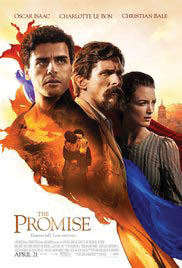 Barlow Der Mugrdechian
Barlow Der Mugrdechian
Advisor
Armenians have long awaited a “Genocide Movie” to bring the story of the Armenian Genocide to a broad audience. Maybe it has been a wish that has had too much expectation built in to it, so that no movie could ever be made to be the movie. However it has been important to have such a movie made in the face of the persistent denial of the Armenian Genocide by the Republic of Turkey since 1923. Armenians have felt that they needed to have their story told, much as they felt that the Holocaust has been so successfully represented in films over the past decades. My comments below do not include a discussion of documentary films based on the Armenian Genocide.
The reasons for the paucity of Armenian genocide-themed movies are complex, but arise primarily from two different key issues. The first comes from trying to answer a fundamental question—how do you represent a catastrophe such as the Armenian Genocide in an esthetic fashion? It has challenged most areas of endeavor including the production of literary works. The second comes from the challenge of finding the right story, to be able to market that story to a Hollywood studio, and then to find the financial resources to complete the production.
Aurora Mardiganian’s memoir, Ravished Armenia, was made into a silent film in 1919 called “Auction of Souls.” But this film did not achieve broad distribution. In 1934, Franz Werfel’s American bestseller “The Forty Days of Musa Dagh” was slated to become an MGM movie. This was a much awaited film, with many expecting it to be a blockbuster on the order of “The Mutiny on the Bounty,” also expected to be released in 1935. But the Turkish Ambassador to the United States, and the Turkish government, learning of the production succeeded in squelching the project with a blend of threats and bluffs.
Thus “The Forty Days of Musa Dagh” had to wait another forty-seven years to be produced and made, not by a Hollywood studio, but by an Armenian-American producer in a low budget production, shown primarily to Armenian audiences.
Atom Egoyan’s “Ararat” released in 2002, was the next major film expected to be the long awaited Genocide movie. While a critical success, “Ararat” did not become the popular breakout movie that many had hoped for. It grossed a paltry $1,554,566 in its worldwide release.
A small parade of other Genocide themed films were made in the succeeding years, among which were “Screamers” (2006), “The Lark Farm” (2007), “The Cut” (2014), and “1915” (2015). None received wide distribution or great attention outside of the Armenian community.
Although many felt the hundredth anniversary of the Armenian Genocide would be the opportunity for the production of a major Genocide-themed movie, it remained until the release of “The Promise” this year to redeem the hopes of Armenians.
It is deja-vu as once again Turkish denialists have attempted almost any means to keep “The Promise” out of theaters, from resorting first to trying to block distribution, and then to writing negative reviews, and finally engaging in tickets scams to keep viewers away.
“The Promise” is now in distribution and has received wide-scale attention in the greater community. Has it fulfilled the hopes of two generations of Armenians? Has it succeeded in relating the story of the Armenian Genocide? Time must pass before we have all of the answers that we seek and for a full assessment to be made.
 Hye Sharzhoom Armenian Action
Hye Sharzhoom Armenian Action